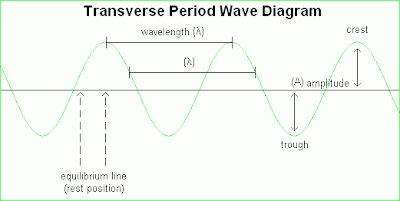7.. THe D note (294 Hz) will be heard more clearly because the frequency is lower therefore having a bigger wavelength.
8. The orange light (610nm)
9.
11.
1 cm = 1/2 ﮑ
2 cm = ﮑ
This blog is for grade 11 students who are studying physics. It is intended to provide a forum for students to discuss, debate and question the topics we cover this semester.


... And also last Friday we watched a video called “Reflection and Refraction”. While watching the video, we were given a sheet, titled “ Physics 11 Waves in Two Dimensions Unit: Reflection and Refraction. Were asked to answer the following questions. The guuureeaat thing about last friday was that we didnt have homework: )
oOYeah, we also have a new student in our class, his name is Aldrin. WELCOME Aldrin ,have a great school year.
......Another thing is that we finished the pharagraph on the study guide booklet:
Diffraction and Interference of Waves
When waves reach a small opening in a barrier, they form circular waves that spread out from the opening. This spreading of waves is called Diffraction. The smaller the waveleght in comparison to the size of the barrie, the less the diffraction. When ther are two opening in a barrier, two sets of circular waves are produced. When the new waves interfere with each other, constructive interference produce large waves, and desctructive interference produces a line of nodes.
Thats pretty much all we did last friday, soo the next scribe will be...innnie minnie miney moe, i choose JUNNEL!, your very welcome, muauuaahhahaa!: )
-ericamaquimot
Hey everyone! It's me, Allison, taking Arlyn's place of scribing for today.We started class off by going over Snell's Law for Water Waves, which can be found on page 12 of our Waves in Two Dimensions booklet. After that, we completed the 3rd page of the Guideline to Drawing Problems booklet. In case you missed it, here are the answers:
a) n = Vd / Vs = 40cm/s / 30cm/s = 1.3
b) λdeep = Vdeep / F = 40cm/s / 10.0 Hz = 4cm
λshallow = Vshallow / F = 30 cm/s / 10 Hz = 3cm
c) There are there possible ways to answer this question.
The first way is:
Vd / Vs = sinθi / sinθr
sinθr = (sinθi)(Vs) / Vd
= (sin30°)(30.0cm/s) / (40.0cm/s)
= (0.5)(30) / 40
sinθ = 0.375
θ = 22°
Another way is:
λd / λs = sinθi / sinθr
sinθr = (sinθi)(λs) / λd
= (sin30°)(3cm) / 4cm
= 0.5(3) / 4
sinθr = 0.375
θr = 22°
And the final way:
n = sinθi / sinθr
sinθr = sin30° / 1.3
θr = 22°
Once we finished that, we were assigned two sheets, both labelled Refraction. I'm guessing they are due tomorrow? If not, then Thursday for sure. We were also given a green sheet which had the index of refraction for different substances as a reference.
Yeah, that was pretty much it. Hmn, the scribe for tomorrows class will be Arlyn Guevarra. I'll see all of you guys in class, haha. Later gater! :) - Allison








 Angle of Incidence = Angle of Reflection
Angle of Incidence = Angle of Reflection 
They were:
The next thing that Ms.Kozoriz handed to us was a new booklet entitled "Waves in Two Dimensions," and also an Excercises sheet. We must read pages 3-4 in the booklet. And after she handed that to us she explained that "Wave fronts are always perpendicular to wave rays." And here is a picture I made on paint that she drew on the board. =).
And that was pretty much it that we did in class. Ahahaha I thought scribing would be harder but it isn't =/ ahaha. Well anyways that is it. OH and I forgot that you need to be bring:
Because we would be making lots of pictures and such. So I will end my scribe here, and next scribe knows who they are so yeah. See you all in class. XD


lynel | Katie N Mark A | Thoa Thoa caaamy deaarly | rawra=) |